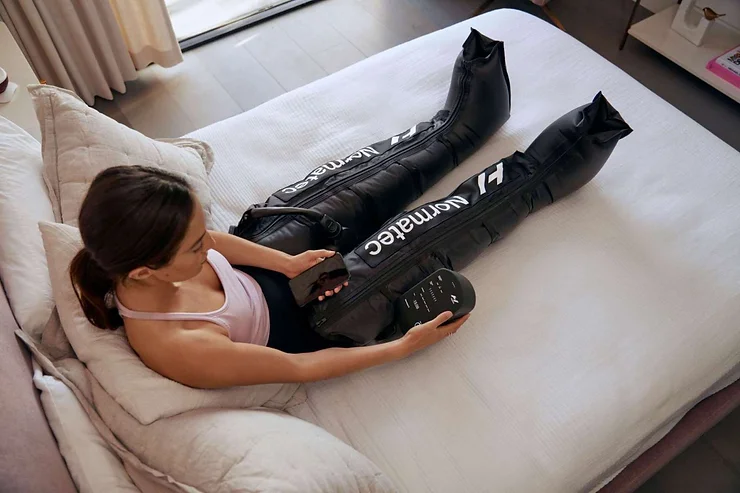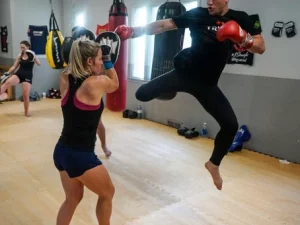Compression therapy has long been recognized as an effective tool in combatting fatigue, helping athletes reach their highest performance levels more quickly and comfortably.

Do you want to move better, feel better, and perform better? Compression therapy may be the answer for you. A popular form of therapy among athletes, compression therapy helps enhance performance and recovery time, so it’s not just for professionals. At Legacy Therapeutics, we carry three top-of-the-line compression therapy brands: Normatec, Air Relax, and our own brand.
Whether you’re an athlete or simply want to improve your health overall, our compression therapy devices can assist with that goal. In this blog post we’ll explain what compression therapy is, its advantages, who can benefit from it, as well as what conditions it helps prevent or improve.
What is Compression Therapy?

Compression therapy is a technique that utilizes pneumatic compression devices to apply controlled pressure to parts of the body. This helps improve circulation, reduce swelling and promotes natural healing processes. Aesthetics and medical professionals have long utilized compression therapy for its beneficial effects on recovery and injury prevention. Now you can enjoy these same advantages right in our clinic with our state-of-the-art compression therapy devices!
Compression Therapy Provides Multiple Benefits
Compression Therapy Improves Circulation: Compression therapy encourages healthy blood circulation throughout the body, providing nourishment to cells and aiding waste elimination. This can prevent circulatory problems and enhance overall wellbeing.
Reduces Swelling: Compression therapy can help reduce swelling in limbs and other parts of the body, especially for those suffering from conditions like peripheral edema or lymphedema that cause uncomfortable swelling.
Relieves Pain: Compression therapy can help relieve nerve compression pain associated with carpal tunnel syndrome or sciatica. Additionally, it releases endorphins and amino acids that act as natural painkillers.
Enhances Recovery: Compression therapy can speed up recovery after a workout or injury. Our Air Compression Device is popular among professional athletes because it reduces soreness and encourages faster healing time.
Compression Therapy Enhances Immunity: Compression therapy works to support and boost the immune system, by improving circulation and decreasing inflammation, in order to help fight off infections and illnesses.
Who Can Benefit From Compression Therapy?
Anyone can benefit from compression therapy, whether you’re an athlete or just want to enhance your health. It is especially helpful for those with conditions like lymphedema, peripheral edema and venous insufficiency. Athletes, dancers and anyone involved in physical activity will find benefits from compression therapy; it helps prevent injuries, reduce soreness and promotes faster recovery times.
Compression Therapy Can Help Prevent and Improve Conditions

Pneumatic Compression therapy is used to improve health and has the potential to prevent and treat a number of conditions, including:
Peripheral Edema: Compression therapy can help reduce swelling in the legs due to fluid buildup in leg tissues.
Lymphedema: Compression therapy improves lymphatic circulation and reduces swelling caused by a blockage in the lymphatic system.
Venous Insufficiency: Compression therapy can improve venous circulation and reduce swelling caused by inadequate function of the one-way valves in veins.
Diabetes: Compression therapy helps promote circulation while preventing diabetic ulcers.
Sports Injuries and Recovery: Compression therapy can help reduce soreness and promote faster recovery after a workout or injury.
At Legacy Therapeutics, our mission is to help our clients move better, feel better and perform better. Compression therapy is just one of many tools we utilize to achieve this end. Our cutting-edge compression therapy devices can improve circulation, reduce swelling, relieve pain and speed up recovery – ideal for athletes or anyone looking to boost their health! Contact us today to book a session and start reaping the rewards today!
Work Cited:
Almeida, S. A., Williams, J. B., Shaffer, R. A., Brodine S. & Aoki T (1999). Epidemiological Patterns of Musculoskeletal Injuries and Physical Training Medicine & Science in Sports & Exercise 31(8) 1176-1182 doi: 10.1097/00005768-199908000-00015
Cavanaugh, M.T., Maupin, D. and Wong J.K. (2021). Deep vein thrombosis prophylaxis in orthopaedic surgery: A narrative review. Journal of the American Academy of Orthopaedic Surgeons 29(2): 53-62 doi: 10.5435/JAAOS-D-19-00768
Cui, J., Xu, F. and Lin X. (2021). Investigating the Effectiveness of Pneumatic Compression Devices in Preventing Deep Vein Thrombosis in Stroke Patients: A Systematic Review and Meta-Analysis. Clinical and Applied Thrombosis/Hemostasis 27(4), 10760296211019303 doi: 10.1177/10760296211019303
Deldicque, L., Francaux, M. and Busetto, R. (2017). Does whole body cryotherapy and pneumatic compression devices combined make for enhanced recovery for elite rugby union players? Journal of Human Kinetics 57(1), 43-50 doi: 10.1515/hukin-2017-0023
Gravante, G., and Russo, G. (2011). Compression therapy in sports. Journal of Sports Medicine and Physical Fitness 51(2), 237-244.
Hodgson, B. F., Laver, L., McCambridge, T. M. and Hunter M. J. (2021). A Systematic Review of the Effects of Intermittent Pneumatic Compression on Lower Limb Edema: Journal of Orthopaedic Surgery and Research 16(1): 217 doi: 10.1186/s13018-021-02466-3
Kibler, W. B. and Chandler, T. J. (1994). Comparison of range of motion in athletes to nonathletes. Journal of Orthopaedic and Sports Physical Therapy 19(6), 357-364 doi: 10.2519/jospt.1994.19.6.357
Marques-Vidal, P., and Bochud, M. (2015). Lymphatic vessel density and integrity in healthy men. Angiology, 66(5), 447-451. doi: 10.1177/0003319714523595
Ozan, A. L., Aytar, A. and Yildiz, S.(2020). Effect of intermittent pneumatic compression on delayed onset muscle soreness and muscle damage among soccer players. Journal of Sports Medicine and Physical Fitness 60(2), 279-284 doi: 10.23736/S0022-4707.19.09908-3
Yoon, J. S., Han, J. H., Yoon, Y. C. & Kim H. J.(2020). Intermittent pneumatic compression effects on peripheral blood flow in healthy adults: A randomized controlled trial. Applied Sciences 10(23), 8475 doi: 10.1021/acs.2018.008475



